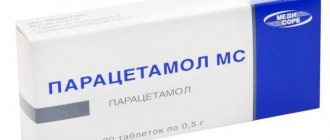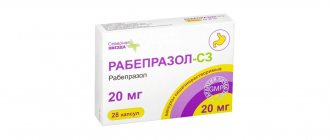The medicine belongs to the type of organotropic gastrointestinal medicines, proton pump inhibitors. It has an antiulcer effect.
Available in tablets (20 mg and 40 mg) with a pink coating, resistant to gastric juice. The shape of the tablets with double-sided engraving is oblong and biconvex. The active ingredient of the drug is Esomeprazole.
Pharmacology
Ulcer treatment - Esomeprazole
The active substance Esomeprazole is the dextrorotatory isomer of omeprazole (S-isomer). Due to the ability of the drug to inhibit (slow down) the proton pump occurring in the parietal cells, the intragastric production of hydrochloric acid decreases.
The S-isomer of omeprazole, which is a weak base, is activated in the secretory tubules, where an acidic environment has formed. This causes inhibition of the proton pump enzyme, which means that the process of stimulated and basal synthesis of hydrochloric acid slows down.
The effect of using a medicinal dose of 20 or 40 mg occurs after an hour. In patients using Esomeprazole 1x20 mg and the stimulant Pentagastrin for 5 days, a decrease in hydrochloric acid by 90% is observed. Patients who are prescribed the medicine at a dosage of 40 mg recover from reflux esophagitis within 28 days (79% of those suffering from the disease) or 56 days (94% of those suffering from the disease).
Safe destruction of Helicobacter pylori occurs in 89% of patients during a 7-day course if they are treated with standard antibacterial medications together with Esomeprazole 2x20 mg. Patients with ulcers that have affected the duodenum and are in an uncomplicated form, after such a course, do not need to undergo monotherapy with the prescription of antisecretory drugs that relieve the symptoms of the disease and heal damaged tissue.
The product is not resistant to acidic environments. Only a small amount of the S-isomer can be converted into the R-isomer. Its absorption rate is high. After an hour or two it reaches the maximum concentration in the body. Repeated single daily intake of 20 mg of the drug ensures absolute bioavailability of Esomeprazole. Plasma proteins bind to the S-isomer by 96%. The drug is able to be metabolized without residue in the presence of cytochrome P450.
Thanks to the polymorphic isoenzyme CYP2C19, the bulk of the medication taken is metabolized. The chain of biochemical transformations ends with the production of de- and hydroxymethylated metabolites. Its residues are metabolized by the CYP3A4 isoenzyme. Biochemical transformations result in the production of the sulfo derivative S-isomer, the main metabolite found in blood serum. The resulting metabolites do not exhibit pharmacological activity.
Esomeprazole-Vial, 14 pcs., 20 mg, enteric-coated tablets
Esomeprazole is the S-isomer of omeprazole and reduces gastric acid secretion by specifically inhibiting the proton pump in gastric parietal cells. The S- and R-isomers of omeprazole have similar pharmacodynamic activities. Mechanism of action.
Esomeprazole is a weak base that transforms into an active form in the highly acidic environment of the secretory tubules of the parietal cells of the gastric mucosa and inhibits the proton pump - the enzyme H + / K + - ATPase, thereby inhibiting both basal and stimulated secretion of hydrochloric acid.
Effect on the secretion of hydrochloric acid in the stomach.
After oral administration of 20 mg or 40 mg, the effect of esomeprazole develops within 1 hour. When taking the drug daily for 5 days at a dose of 20 mg once a day, the average maximum concentration of hydrochloric acid after stimulation with pentagastrin is reduced by 90% (when measuring the acid concentration 6-7 hours after taking the drug on the 5th day of therapy).
In patients with gastroesophageal reflux disease (GERD) and clinical symptoms, after 5 days of daily oral esomeprazole 20 mg or 40 mg, intragastric pH values above 4.0 were maintained for an average of 13 and 17 hours out of 24 hours. When taking esomeprazole at a dose of 20 mg per day, intragastric pH values above 4.0 were maintained for at least 8, 12 and 16 hours in 76%, 54% and 24% of patients, respectively.
A correlation was identified between the concentration of the drug in plasma and the inhibition of hydrochloric acid secretion (to assess the concentration, the AUC parameter was used - the area under the concentration-time curve). The therapeutic effect achieved as a result of inhibition of hydrochloric acid secretion.
When taking the drug at a dose of 40 mg, healing of reflux esophagitis occurs in approximately 78% of patients after 4 weeks of therapy and in 93% of patients after 8 weeks of therapy.
Treatment with esomeprazole 20 mg twice daily in combination with appropriate antibiotics for one week results in successful eradication of Helicobacter pylori in approximately 90% of patients. Patients with uncomplicated peptic ulcer disease after a week-long eradication course do not require subsequent monotherapy with drugs that reduce the secretion of gastric glands to treat the ulcer and eliminate symptoms. The effectiveness of esomeprazole in bleeding from peptic ulcers, confirmed endoscopically, has been shown.
Other effects associated with inhibition of hydrochloric acid secretion During treatment with drugs that reduce the secretion of gastric glands, the concentration of gastrin in the plasma increases as a result of a decrease in the secretion of hydrochloric acid. Due to decreased secretion of hydrochloric acid, the concentration of chromogranin A (CgA) increases. Increased concentrations of CgA may affect the results of examinations for the detection of neuroendocrine tumors. To prevent this effect, it is necessary to temporarily stop taking esomeprazole 5 days before the CgA concentration test.
In patients receiving esomeprazole for a long time, an increase in the number of enterochromaffin-like cells was observed, probably associated with an increase in plasma gastrin concentrations.
Patients taking drugs that reduce the secretion of gastric glands for a long period of time are more likely to develop glandular cysts in the stomach. These phenomena are caused by physiological changes as a result of pronounced inhibition of hydrochloric acid secretion. Cysts are benign and undergo reverse development.
The use of drugs that suppress the secretion of hydrochloric acid in the stomach, including proton pump inhibitors, is accompanied by an increase in the content of microbial flora in the stomach that is normally present in the gastrointestinal tract. The use of proton pump inhibitors may lead to a slight increase in the risk of infectious diseases of the gastrointestinal tract caused by bacteria of the genus Salmonella spp. and Campylibacter spp and possibly Clostridium difficile in hospitalized patients.
In two comparative studies with ranitidine, esomeprazole was superior in treating gastric ulcers in patients receiving nonsteroidal anti-inflammatory drugs (NSAIDs), including selective cyclooxygenase-2 (COX-2) inhibitors.
Indications
The medication is prescribed:
- People with signs of gastroesophageal reflux disease.
- To prevent relapse that may occur in a patient freed from esophagitis.
- When conducting therapy for those who suffer from erosive reflux esophagitis.
- For the therapeutic treatment of gastroesophageal reflux disease.
- In an integrated approach to suppressing peptic ulcers caused by Helicobacter pylori (used as a preventive and therapeutic agent).
Directions for use and dosage
Esomeprazole is intended for internal use. The tablets are swallowed whole (breaking and chewing is unacceptable) followed by drinking water. For erosive reflux esophagitis, 1 tablet of 40 mg per day is prescribed for 4 weeks. If the course does not bring relief (the symptoms of the disease do not disappear), repeat therapy of the same duration is carried out.
In order to prevent relapse after an attenuated disease, 1 tablet of 20 mg is prescribed daily.
Symptomatic therapy for the occurrence of gastroesophageal reflux disease is carried out by prescribing 1 tablet of 20 mg per day (for those who are not burdened with signs of esophagitis). If the 28-day treatment does not help, the patient is examined again.
Esomeprazole
The drug is used orally, parenterally intravenously.
The drug in the form of film-coated tablets is used orally. The tablet should be swallowed whole with liquid. Tablets should not be chewed or broken. For patients with difficulty swallowing, you can dissolve the tablets in half a glass of still water.
Adults and children from 12 years old
Gastroesophageal reflux disease
Treatment of erosive reflux esophagitis: 40 mg once a day for 4 weeks. An additional 4-week course of treatment is recommended in cases where, after the first course, healing of esophagitis does not occur or symptoms persist.
Long-term maintenance treatment after healing of erosive reflux esophagitis to prevent relapse: 20 mg once a day.
Symptomatic treatment of gastroesophageal reflux disease: 20 mg once daily in patients without esophagitis. If symptoms do not disappear after 4 weeks of treatment, the patient should be further examined. After eliminating the symptoms, you can switch to the “as needed” regimen of the drug, i.e. take 20 mg once daily when symptoms return. For patients taking NSAIDs who are at risk of developing gastric or duodenal ulcers, treatment on an 'as needed' basis is not recommended.
Adults
Peptic ulcer of the stomach and duodenum
As part of combination therapy for Helicobacter pylori eradication:
treatment of duodenal ulcer associated with Helicobacter pylori: the drug 20 mg, amoxicillin 1 g and clarithromycin 500 mg. All drugs are taken twice a day for 1 week.
Prevention of relapse of peptic ulcers associated with Helicobacter pylori: drug 20 mg, amoxicillin 1 g and clarithromycin 500 mg. All drugs are taken twice a day for 1 week.
Long-term acid suppression therapy in patients who have suffered bleeding from a peptic ulcer (after intravenous use of drugs that reduce the secretion of gastric glands to prevent relapse) 40 mg of the drug 1 time per day for 4 weeks after the end of intravenous therapy with drugs that reduce the secretion of gastric glands.
Patients taking NSAIDs for a long time:
- healing of stomach ulcers associated with taking NSAIDs: 20 mg or 40 mg once a day. The duration of treatment is 4-8 weeks.
- prevention of gastric and duodenal ulcers associated with taking NSAIDs: 20 mg or 40 mg once a day.
Conditions associated with pathological hypersecretion of the gastric glands, including Zollinger-Ellison syndrome and idiopathic hypersecretion: The recommended starting dose is 40 mg twice daily. In the future, the dose is selected individually, the duration of treatment is determined by the clinical picture of the disease.
If it is impossible to carry out oral therapy, patients may be recommended to prescribe the drug parenterally at a dose of 20-40 mg once a day, for which a lyophilisate is used to prepare a solution for intravenous administration.
Contraindications, side effects and consequences of overdose
The drug is not prescribed to people with hypersensitivity to its components, including substituted benzimidazoles. Do not prescribe the medication simultaneously with Atazanavir (combined use of drugs results in a decrease in the concentration of Atazanavir). Its use is contraindicated during pregnancy and lactation.
Taking Esomeprazole may cause headaches, abdominal pain, flatulence, nausea and vomiting. Its use can result in constipation, dermatitis, dizziness, hives, itching, and dry mouth.
An overdose of the drug results in general weakness and unpleasant symptoms from the gastrointestinal tract. Signs of overdose are relieved by symptomatic treatment. Dialysis in this case is ineffective. There is no specific antidote.
Restrictions on use
Today there is no information available anywhere about prescribing the drug for pregnant and lactating women. Administration of the drug to animals did not negatively affect the development of embryos and young. After the administration of the racemic drug, the health of animals at the stage of pregnancy, childbirth and the postnatal period was not affected.
However, it is advisable to prescribe the drug during pregnancy when the intended benefit for the woman does not result in a potential risk for the baby. Since there is no data on the penetration of the drug into breast milk, treatment of nursing mothers with Esomeprazole is unacceptable.









